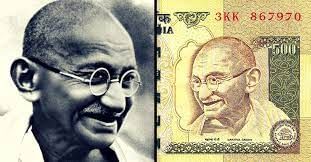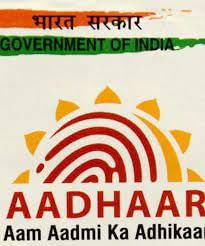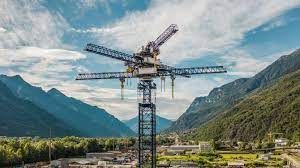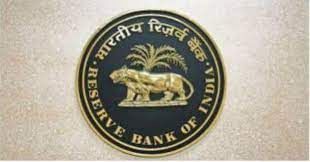UPSC Daily Current Affairs- 2nd October 2023 | Current Affairs & Hindu Analysis: Daily, Weekly & Monthly PDF Download
GS-I
Story of Mahatma Gandhi’s Portrait on Indian Banknotes
Subject: History

Why in News?
Mahatma Gandhi seems a natural choice for the face of Indian currency as the Father of the Nation.
- This wasn’t until 1996 that his image became a permanent fixture on legal banknotes issued by the RBI, the nation’s central bank and regulatory authority for the Indian banking system.
Gandhi’s Portrait on Indian Currency
- Photographic Source: The portrait of Gandhi on Indian banknotes is not a caricature but a cut-out from a 1946 photograph featuring him alongside British politician Lord Frederick William Pethick-Lawrence.
- Expression Matters: This particular photograph was chosen for its ideal depiction of Gandhi’s smiling visage, and the portrait is a mirrored image of the cut-out.
- Unknown Photographers: Interestingly, the identities of the photographer of this image and the person who selected it remain unknown.
Currency Design Process
- RBI’s Responsibility: The RBI’s Department of Currency Management is tasked with designing rupee notes, subject to approval from the central bank and the Union government.
- Regulatory Framework: Section 25 of the RBI Act, 1934, mandates that the design, form, and material of banknotes must be approved by the central government after considering the central board’s recommendations.
Gandhi’s Debut on Indian Currency
- 1969 Commemoration: Gandhi made his first appearance on Indian currency in 1969 through a special series issued to commemorate his 100th birth anniversary. These notes, featuring Gandhi alongside the Sevagram Ashram, bore the signature of RBI governor LK Jha.
- 1987 Inclusion: In October 1987, a series of Rs 500 currency notes featuring Gandhi was introduced.
The Transition to Independent India’s Banknotes
- Post-Independence Currency: Initially, after India gained independence in August 1947, the RBI continued to issue notes from the colonial era that depicted King George VI.
- Symbol Selection: The government of India introduced new 1-rupee notes in 1949, replacing King George with a representation of the Lion Capital of Ashoka Pillar at Sarnath.
- Design Continuity: The subsequent release of banknotes in 1950, in denominations of Rs 2, 5, 10, and 100, featured the Lion Capital watermark, maintaining continuity with earlier designs.
Gandhi’s Permanence on Banknotes
- Security Concerns in the 1990s: By the 1990s, the RBI recognized the need for enhanced security features on currency notes due to advancements in reprographic techniques. A human face was deemed less susceptible to forgery than inanimate objects.
- Gandhi’s Enduring Appeal: Mahatma Gandhi’s national significance made him the ideal choice. In 1996, the RBI introduced a new ‘Mahatma Gandhi Series’ of banknotes, replacing the previous Ashoka Pillar notes and incorporating advanced security features.
- Continuity in 2016: The ‘Mahatma Gandhi New Series’ of banknotes, introduced in 2016, continued to feature Gandhi’s portrait, with the addition of the Swachh Bharat Abhiyan logo and enhanced security elements.
Other Suggestions for Currency Faces
- Varied Proposals: Over the years, there have been calls to feature different personalities on banknotes apart from Gandhi.
- Lord Ganesha and Goddess Lakshmi: In October 2022, Delhi Chief Minister Arvind Kejriwal appealed to the Prime Minister and the Union government to include images of Lord Ganesha and goddess Lakshmi on currency notes.
- Previous Proposals: Suggestions in the past included Noble Laureate Rabindranath Tagore and former President APJ Abdul Kalam. However, the RBI and Indian authorities have consistently upheld Gandhi’s representation, considering him the most fitting embodiment of India’s ethos.
Conclusion
- Gandhi’s Enduring Legacy: Mahatma Gandhi’s presence on Indian currency notes stands as a testament to his indelible impact on the nation’s history and values.
- Challenges to Change: While various proposals have emerged over the years, the symbolism and significance of Gandhi on banknotes remain unwavering, reflective of his towering stature in India’s collective consciousness.
Source: The Hindu
Duarte Agostinho Case: A Youth-led Climate Lawsuit
Subject: Geography

Why in News?
On September 27, a historic legal battle in the climate action movement commenced at the European Court of Human Rights in Strasbourg, France.
- This courtroom showdown featured 32 European governments, including the UK, Russia, and Turkey, facing off against six young individuals from Portugal, aged 11 to 24.
Why discuss this?
- Youth-led climate lawsuits are reshaping climate litigation.
- These lawsuits assert that uncontrolled carbon emissions infringe on fundamental rights, threaten the well-being of young generations.
- This highlight the centrality of climate science in combating misinformation and denialism.
Understanding the Duarte Agostinho Case
[A] Origins of the Lawsuit:
- The Duarte Agostinho and Others v. Portugal and Others case was initiated in September 2020.
- It was in response to the devastating wildfires in Portugal’s Leiria region in 2017, resulting in 66 casualties and the loss of 20,000 hectares of forests.
- This legal action highlights the urgency of adhering to the Paris Agreement’s target of limiting global warming to below 1.5°C.
[B] Concerns raised
- The Portuguese youths assert that European nations have failed to meet climate emissions goals, exceeding global carbon budgets compatible with the Paris Agreement’s objectives.
- Scientific evidence will be presented, demonstrating that if current emission trends persist, global temperatures will rise by 3°C during the plaintiffs’ lifetimes.
- Such actions are alleged to breach fundamental rights protected under the European Convention on Human Rights, including the right to life, freedom from inhuman or degrading treatment, privacy, family life, and freedom from discrimination.
Lawsuit’s Demands
- Rapid Emission Reduction: As these 32 countries contributed to climate catastrophes and threatened young people’s futures, the lawsuit contends that these nations must urgently intensify emissions reductions. The recommended measures include curbing fossil fuel production and addressing global supply chain sustainability.
- Emissions Reduction Targets: The European Scientific Advisory Board on Climate Change (ESABCC) suggested that countries should aim for emissions reductions of 75% below 1990 levels, a more ambitious target than the EU’s current 55%. The lawsuit argues that European countries have overstated their carbon budgets, emphasizing the need for greater reductions.
Climate Crisis Impact on Human Rights
- UNICEF characterizes the climate crisis as a “child rights crisis” due to unhindered carbon emissions and extreme weather jeopardizing access to education, health, nutrition, and the future.
- Research links air pollution to adverse birth outcomes and increased risks of cardiovascular and respiratory diseases.
- Heatwaves exacerbate mental health issues, ultimately affecting academic performance and school attendance.
Government Responses and Challenges
- Cause and Effect Denial: Many countries have dismissed any direct relationship between climate change and its impact on human health. Greece, for instance, argued that climate change effects do not directly affect human life or health, despite experiencing massive wildfires.
- Portrayal as Future Fears: Governments like Portugal and Ireland have downplayed climate change concerns as “future fears,” asserting that there is no immediate risk to lives.
- Policy Reversals: Some nations, like the U.K., have showcased proactive climate policies, such as a 2030 ban on the sale of new petrol and diesel cars. However, these policies have been reversed, raising concerns about policy consistency and legality.
Conclusion
- The Duarte Agostinho case represents a pivotal moment in the climate action movement, with young activists challenging their governments to protect their future against the looming climate crisis.
- This legal battle underscores the critical intersection of climate change and human rights, shaping a path toward increased accountability and transformative climate governance.
Source: The Hindu
GS-II
Parliamentary Committee’s Report on Protected Monuments
Subject: Polity

Why in News?
A Parliamentary Committee report tabled during the recent special session aims to prune the list of protected monuments in India.
Background:
- 359th report on functioning of Archaeological Survey of India (ASI) was prepared by the department-related Parliamentary Standing Committee on Transport, Tourism & Culture.
- The committee observed that many of the 3,691 Centrally Protected Monuments (CPMs) are “minor” monuments with no national significance.
- The committee recommended that the list should be “rationalized and categorized” on the basis of the structure’s significance and architectural/ heritage value.
- The list includes 75 graves of colonial-era soldiers or officials, which may not hold significant heritage value in the present time.
- A small brick wall enclosure containing graves of two British officials in Karnataka is a protected monument, the report pointed out.
- Yet, they are getting the same level of protection as the Red Fort or the Taj Mahal.
- Hence, the committee suggests that the list of CPMs in India should be rationalized on the basis of their national significance.
Can Monuments be Dropped from the Protected List?
- List of Protected Monuments is regulated by the Ancient Monuments and Archaeological Sites and Remains Rules, 1959 (AMASR Act).
- The Act protects monuments and sites that are more than 100 years old, including temples, cemeteries, inscriptions, tombs, forts, palaces, step-wells, rock-cut canes, and even objects like cannons and mile pillars that may be of historical significance.
- To remove certain monuments from the CPM list, AMASR Act has to be amended in the Parliament.
Other Major Recommendations of the Committee:
- ASI’s Functioning:
- The committee has raised questions about the functioning of the ASI, in terms of its administration, security, restoration work and general upkeep of the sites.
- The committee said that till date, 531 monuments, about 14.4% of the total CPMs, have been encroached upon.
- However, encroachments from only nine monuments have been removed since 2015.
- The committee recommended that the ASI should provide support to families affected in the process of encroachment removal and help them transition to alternative livelihoods.
- It also advocated the use of advanced technologies such as LiDAR, ground-penetrating radar, and 3D scanning for enhanced accuracy and efficiency of excavations.
- Bifurcation of ASI:
- The report advised bifurcation of the ASI on the basis of cerebral and managerial functions.
- The ASI can look after the core mandate – exploration, excavation and conservation aspects.
- On the other hand, the India Heritage Development Corporation (IHDC) can deal with the revenue aspect, such as ticket collection, auctions, etc.
- Restrictions on Monuments:
- Currently, under AMASR Act, there is a provision of a 100-metre prohibited area and 300-metre regulated area around all ASI protected monuments.
- It prohibits and regulates all activities like mining and construction around the stipulated area of all protected monuments.
- The committee found that this leads to public inconvenience.
- The report said that in some cases, an entire village is within a radius of 300 metres from a monument, which makes it difficult for residents to repair their houses.
Way Forward:
- The Central government is already working to amend the above-mentioned rules.
- In recent times, there have been instances where this rule came in the way of infrastructural projects and real-estate development, as it applies equally to significant and insignificant monuments.
- It is expected that the rules will be relaxed for smaller monuments like statues, cannons, etc. but retained for the 42 UNESCO World Heritage Sites located across the country.
Central Authorities Involved in Regulating Monuments:
- About National Monuments Authority (NMA):
- National Monuments Authority is a statutory body set up under the provisions of the Ancient Monuments and Archaeological Sites and Remains AMASR (Amendment and Validation) Act, 2010.
- Functions of NMA:
- Make recommendations to the Central Government for grading and classifying protected monuments and protected areas declared as of national importance.
- Oversee the working of the Competent Authorities.
- To consider the impact of large-scale development projects, including public projects and projects essential to the public which may be proposed in the regulated areas and make recommendations in respect thereof to the competent authority.
- To make recommend actions to the competent authority for grant of permission.
- Difference between NMA & ASI:
- Archaeological Survey of India (ASI) is a statutory body, under the AMASR Act, 1958.
- ASI is responsible for archaeological research and the conservation and preservation of cultural monuments in the country.
- ASI is also responsible for conducting archaeological surveys, explorations and excavations in the country.
- On the other hand, NMA’s duty is to provide protection and preservation of monuments and sites.
- It is not tasked with conducting surveys, explorations and excavations.
- Applications for construction related work in the prohibited and regulated area are submitted to the NMA and not ASI.
- NMA only regulates AMASR Act, 2010; on the other hand ASI regulates AMASR Act, 1958 as well as Antiquities and Art Treasure Act, 1972.
Source: The Hindu
The concerns of using Aadhaar in welfare
Subject: Polity

Why in News?
On September 21, Moody’s Investor Service released a report advocating for decentralized digital identity systems over centralized biometric systems like India’s Aadhaar
Central idea
- India has reacted strongly to the report released by Moody’s Investor Service, which advocates for decentralized digital identity systems over central biometric systems like Aadhaar. The government has refuted the claims made in the report and defended the Aadhaar system as the most trusted digital ID in the world.
What is Aadhaar?
- Aadhaar is a 12-digit unique identification number issued to all Indian residents by the Unique Identification Authority of India (UIDAI).
- It is based on biometric and demographic data, including fingerprints and iris scans, and serves as a standardized and secure means of identity verification.
The Rationale for Aadhaar
- Unique Identification: Aadhaar assigns a unique ID to every Indian resident, ensuring distinct and verifiable identities.
- Corruption Reduction: Aadhaar combats welfare fraud by verifying recipients, reducing ghost and fake beneficiaries.
- Efficient Services: Simplifies access to government services, enhancing efficiency and accuracy.
- Financial Inclusion: Links Aadhaar to bank accounts, promoting banking services in underserved areas.
- Digital Transformation: Enables secure online authentication for e-services, e-commerce, and payments.
- Data Security: Emphasizes data security and privacy measures, including encryption and authentication protocols.
- Integration: Supports government database integration, enhancing governance and policy implementation.
- Welfare Savings: Eliminates duplicates, leading to substantial savings and improved subsidy targeting.
Role in cash withdrawals
- Aadhaar and Job Card Linking: First, a worker’s Aadhaar number must be linked to their job card, which is associated with the employment program, such as MGNREGA.
- Aadhaar and Bank Account Linking: Second, the worker’s Aadhaar must be linked to their bank account. This linkage ensures that the Aadhaar number serves as the unique identifier for transactions related to this account.
- Mapping with NPCI: The Aadhaar number must be correctly linked through the worker’s bank branch with the National Payments Corporation of India (NPCI). The NPCI acts as a clearing house for Aadhaar-based payments.
- Cash Deposits: Once these linkages are established, any cash transferred by the government for benefits or payments gets deposited directly into the individual’s last Aadhaar-linked bank account.
- Cash Withdrawals: Individuals can then withdraw money from their Aadhaar-linked bank account through private banking kiosks or by using private banking correspondents’ point of sale (PoS) machines. These transactions involve biometric authentication to confirm the individual’s identity.
Concerns with Aadhaar’s Use
- Ineffectiveness Against Quantity Fraud: Aadhaar does not address quantity fraud, a prevalent form of corruption in ration distribution, where beneficiaries receive less than their entitled amount. The system focuses on identity verification but lacks mechanisms to prevent this type of fraud.
- Authentication Challenges: In rural areas, authentication can be challenging due to unreliable internet, fading fingerprints, and limited phone connectivity for one-time passwords (OTPs). Multiple trips to ration shops may be necessary, leading to delays and uncertainty.
- Lack of Transparency: The lack of public data on authentication attempts and failures raises transparency and accountability issues. The Comptroller and Auditor General of India (CAG) highlighted the absence of a system to analyze authentication errors.
- Payment Failures: Any error in the Aadhaar-based payment process can result in payment failures. Issues like spelling discrepancies between job cards and Aadhaar databases can lead to authentication failures.
- Coercion and Misdirection: Workers are often coerced into linking their Aadhaar with bank accounts without their consent, leading to wage diversion to unknown accounts. Misdirected payments, such as redirection to Airtel wallets, are challenging to detect and resolve.
- Savings Claims: Claims of government savings through Aadhaar implementation have been questioned by researchers like Jean Drèze, Reetika Khera, Rahul Lahoti, and Anand Venkatnarayanan. They argue that the government’s assertions may be misleading and not supported by data.
- Delays in Wage Payments: Despite government claims of reduced delays in wage payments under MGNREGA due to Aadhaar, recent research using extensive wage transaction data found no statistical evidence of these claims. Insufficient funds were suggested as a primary reason for payment delays
Security Concerns with Aadhaar
- Lack of Accountability: Banking correspondents operating the Aadhaar-enabled Payment System (AePS) often lack a robust accountability framework, raising the risk of misuse or unauthorized access to individuals’ bank accounts.
- Unauthorized Biometric Authentication: Some banking correspondents may ask individuals to undergo multiple biometric authentications, potentially granting them unauthorized access to individuals’ bank accounts.
- Misuse of Aadhaar-Enabled Transactions: Reports and studies have highlighted cases where individuals’ money was withdrawn without consent through AePS, or they were enrolled in government insurance programs against their will.
- Security Breaches: Instances like the ₹10 crore scholarship scam in Jharkhand in 2020 exemplify security breaches and fraudulent activities associated with Aadhaar-based systems.
Way forward
- Data Security and Privacy: Strengthen data security measures to protect Aadhaar information. Ensure strict enforcement of data protection regulations and privacy standards.
- Authentication Reliability: Improve the reliability of biometric authentication, especially in areas with limited connectivity. Develop backup authentication methods.
- Process Streamlining: Simplify the process of linking Aadhaar with bank accounts and other services to reduce errors and misdirected payments. Provide clear information to individuals about the status and usage of their Aadhaar-linked accounts.
- Addressing Corruption: Monitor and evaluate the impact of Aadhaar on reducing corruption in welfare programs. Implement additional measures to tackle specific forms of corruption, such as quantity fraud.
- Independent Research and Evaluation: Support independent research to assess Aadhaar’s effectiveness and impact in various government programs. Use evidence-based findings to make informed policy decisions and improvements.
- Accountability for Misuse: Establish mechanisms for holding individuals or organizations accountable for any misuse of Aadhaar data or fraudulent activities.
Conclusion
- Moody’s report has sparked a debate about the effectiveness and security of Aadhaar. While it has brought some benefits in streamlining welfare programs, it falls short in addressing key issues and poses significant security risks. The government must address these concerns and work towards a more secure and efficient digital identity system, considering decentralized alternatives as suggested by Moody’s.
Source: The Hindu
GS-III
Gravity battery: How gravity may solve green power’s problem
Subject: Science and Technology

Why in News?
As countries step up renewable energy capacity addition, there is growing urgency to develop long-duration energy storage systems.
- Gravity batteries are emerging as the best bet in solving renewable energy’s biggest problem - intermittency.
What is a Gravity Battery?
- A gravity battery is a type of electricity storage device that stores gravitational energy, the energy stored in an object resulting from a change in height due to gravity, also called potential energy.
- A gravity battery works by using excess energy (usually from sustainable sources) to raise a mass to generate gravitational potential energy.
- This is then lowered to convert potential energy into electricity through an electric generator.
- The most common gravity battery is used in pumped-storage hydroelectricity (PSH), where water is pumped to higher elevations to store energy and released through water turbines to generate electricity.
- Another form of a gravity battery lowers a mass, such as a block of concrete, to generate electricity.
- As of 2019, the total world capacity for PSH is 168 GW (gigawatts). The US has 23 GW capacity from PSH, accounting for nearly 2% of the energy supply system and 95% of utility-scale energy storage in the US.
- Gravity based pumped-storage electricity is currently the largest form of grid energy storage in the world.
Development of Long-duration Energy Storage Systems:
- As countries step up renewable energy capacity addition, there is growing urgency to develop long-duration energy storage systems.
- These systems could be installed alongside green power generation to balance out the variability in renewable power, given that green generation is not always in sync with the electricity demand cycle.
- Energy Vault (a Swiss company founded in 2017), a developer of utility-scale storage technology, is offering a proprietary gravity-based storage, to plug this gap.
- Energy Vault’s proprietary ‘EVx’ platform utilises gravity and a mechanical elevator system to stack 35-tonne blocks made of a composite material at the top of a towering structure.
- When the electricity demand is low, the elevator uses surplus electricity from the grid or electricity generated by renewable plants, to raise these blocks and line them up at the top of the structure.
- When electricity demand picks up, the blocks are then lowered one by one, releasing kinetic energy that is used to rotate a motor and generate electricity, which can then be pumped back to the grid.
Advantages of the ‘EVx’ Platform:
- This type of energy storage could be an innovative solution for countries (including India).
- It can solve the biggest impediments to wider deployment of renewable generation - the ability for power companies to store energy for use by consumers when the sun is not shining or the wind is not blowing.
- This could also facilitate the shift to a circular economy while ensuring clean energy transition.
Gravity Batteries vs Lithium-ion Batteries:
- Gravity batteries are not the only way renewable energy can be stored, lithium-ion batteries dominate the market and some experts favour green hydrogen.
- But gravity is free, clean and easily accessible, without the complications of producing hydrogen or the environmental and human rights concerns linked to some lithium mining.
- While lithium-ion batteries lose capacity after they have been charged and recharged over years, the gravity systems are made of robust components which will last much longer.
India’s Renewable Energy Push and Challenges:
- The country is the world’s third largest producer of renewable energy and nearly 40% of installed electricity capacity comes from non-fossil fuel sources.
- This green push has resulted in a 24% reduction in emission intensity of GDP between 2005 and 2016, but it has also thrown up challenges of a grid being increasingly powered by renewables.
- Also, grid managers are already grappling with the challenge of operationally sustaining a massive monthly addition of an average 1,000 megawatt from renewables to the electricity grid.
- Policy makers are of the view that New Delhi needs to expeditiously work on developing viable energy storage options.
- There are two alternatives being considered by the government for now: hydrogen and hybrid generation models blended with off-stream pumped storage.
Developments in India in the Field of Gravity Battery Storage Systems:
- India’s push for deployment of large-scale renewable power makes storage a prerequisite to support this expansion.
- Energy Vault is in the process of establishing a base in Bengaluru. It is in talks with NTPC Ltd (India’s biggest generation utility), Mumbai-based Tata Power and green energy company ReNew Power for collaborations.
- NTPC had signed an MoU last year for a long-term strategic partnership for the deployment of Energy Vault’s EVx energy storage technology and software solutions.
Source: Indian Express
RBI policy - Why MPC is likely to maintain repo rate pause
Subject: Economics

Why in News?
The Monetary Policy Committee (MPC) of the RBI is expected to keep the repo rate unchanged at 6.5 per cent for the fourth consecutive time, as consumer price index (CPI) based inflation continues to remain sticky.
- MPC will meet from October 4 to 6.
- Experts believe that the central bank is also likely to maintain its withdrawal of accommodation stance in the policy.
- Withdrawal of accommodation means reducing the money supply in the system to rein in inflation further.
- On the other hand, an accommodative stance means the central bank is prepared to expand the money supply to boost economic growth.
What is Monetary Policy Committee (MPC)?
- The Committee
- Under Section 45ZB of the amended RBI Act, 1934, the central government is empowered to constitute a six-member Monetary Policy Committee (MPC).
- MPC will determine the policy interest rate required to achieve the inflationtarget. The first such MPC was constituted in September 2016.
- Members of MPC
- As per the amended RBI act, the MPC shall consist of
- RBI Governor as its ex officio chairperson,
- Deputy Governor in charge of monetary policy,
- an officer of the Bank to be nominated by the Central Board, and
- three persons to be appointed by the central government.
- As per the amended RBI act, the MPC shall consist of
- Functions of MPC
- Setting Policy Interest Rates: The primary function of the MPC is to determine the policy interest rates, specifically the repo rate.
- Inflation Targeting: The current inflation target set by the government is a Consumer Price Index (CPI) inflation target of 4% with a tolerance band of +/- 2%.
- Economic Analysis and Forecasting: The MPC conducts thorough analysis and forecasting of various economic indicators, including inflation, GDP growth, employment, fiscal conditions, and global economic developments.
- Decision-Making: The MPC meets at least four times a year to review the monetary policy stance.
News Summary: RBI policy - Why MPC is likely to maintain repo rate pause
Why is RBI likely to maintain status quo?
- Domestic challenges
- These domestic challenges include:
- growing risks to consumption demand amid soaring food inflation,
- an uneven monsoon adversely affecting kharif crops,
- higher interest rates
- Inflation is still high at 6.8 per cent. While it is expected to come down sharply, there is still some pessimism on Kharif output, especially relating to pulses, which has the potential to push up prices further.
- Earlier, RBI Governor said the frequent incidences of recurring food price shocks pose a risk to anchoring of inflation expectations, which has been underway since September 2022.
- These domestic challenges include:
- External challenges
- rising global crude oil prices
- International crude oil prices have averaged nearly $89 per barrel.
- At the time of the last RBI policy, oil prices averaged around $79 per barrel, implying a 12.6 per cent jump in prices since the previous policy.
- Russia – Ukraine war
- Russia – Ukraine war is further creating a supply-chain bottlenecks for many commodities.
- rising global crude oil prices
Will there be a change in GDP growth forecast?
- As per experts, the RBI is unlikely to change its GDP forecast in the upcoming monetary policy.
- The growth fundamentals still remain strong but the key uncertainty remains around the impact of a weak monsoon on agriculture production.
- Also, there is expectation of continued slowdown in Europe and China, weaker exports, and risks to rural demand on the back of weak monsoon activity this year.
Will any liquidity measure be announced?
- As per the experts, the RBI is unlikely to announce any specific liquidity measures as it is tight today.
- Also, the RBI is in the process of rolling back the incremental cash reserve ratio (I-CRR) which was invoked in the August policy.
- I-CRR is an additional cash balance that banks must maintain over and above the standard CRR.
- The standard CRR is the percentage of deposits that banks are required to keep with the RBI.
- The RBI announced the discontinuation of the I-CRR on September 8.
- I-CRR is an additional cash balance that banks must maintain over and above the standard CRR.
- Despite the gradual withdrawal of the I-CRR, systemic liquidity continued to stay in the deficit since mid-September due to quarterly tax outflows and GST payments.
- Additionally, interventions in the foreign exchange market aimed at supporting the rupee may have marginally contributed to some absorption of rupee liquidity.
Source: The Hindu
|
63 videos|5408 docs|1146 tests
|
















